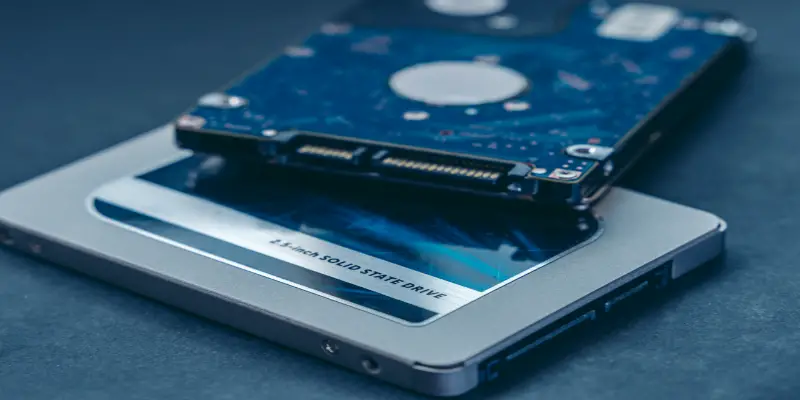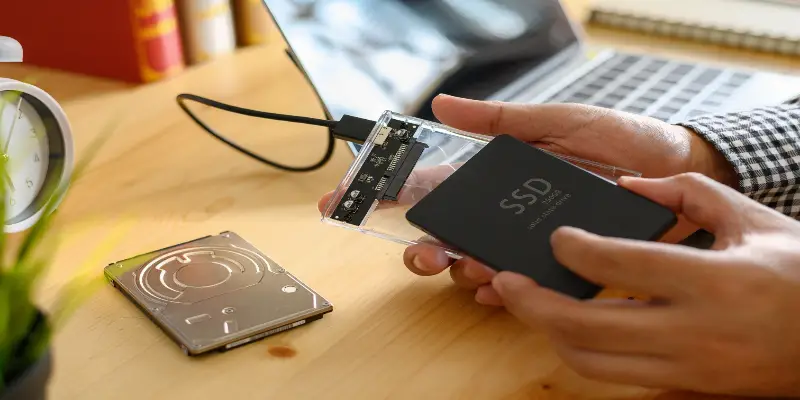Disclaimer: This post may contain affiliate links, meaning we get a small commission if you make a purchase through our links, at no cost to you. For more information, please visit our Disclaimer Page.
If you’ve bought an SSD, you might be wondering if you need to partition it. Partitioning your SSD isn’t necessary for some, but it can come in handy for certain scenarios.
In practice, partitioning will not affect your SSD’s performance, but it can have an impact on your storage capacity. Partitioning drives have both pros and cons; the user needs to weigh up which option is more beneficial. However, a complete wipeout is recommended for OS reinstallation.
Table of Contents
Is Partitioning SSD Bad?
Mechanical hard disk drives used to be the standard for storing digital data. Disk partitioning for HDDs is necessary to minimize the wear and tear of the magnetic platter. It also enhances the read and write performances, resulting in a more seamless and better data transfer. But this rule does not apply to SSDs.
Instead of using physically moving components, Solid State Drives or SSDs use “flashing” to write files. Hence, the digital data on these storage systems can be accessed instantly. There are no enhancements or bottlenecks that happen whether you partition your SSDs or not. It all boils down to the preferences of the user.
But can other factors relating to partitioning make the SSD slower over time? What about formatting and partitioning your drive to replace your current Windows installation?
Although SSD partitioning is harmless, there is still a possible performance problem that a user might encounter, and we will learn more about it below.
Does Partition Slow Down SSD?
Unlike HDDs, there is no need to partition solid-state drives to gain performance improvements. But although it doesn’t give any boost, it doesn’t cause slowness either. Here is why partitioning has been known to give performance boosts for mechanical HDDs in the past.
Why Partitioning Is Necessary On HDDs?
Mechanical hard drives are restricted by the physical speed of the magnetic platter. Finding a file and modifying it would take a toll on the drive’s capacities, which will make the wear-and-tear factor more damaging to the device.
This is where partitioning is very useful: it minimizes the time for the magnetic head to find the right data by reducing the search area to cover. Although it might not seem like something that can optimize drive performance.
Another method that utilizes the benefits of partitioning is called “short-stroking.” In this method, the most accessed files are stored in the best-performing sectors of the drive. Meanwhile, all the less speed-reliant files will go into less-accessed parts of the drive.
Partitioning On SSDs
Because SSDs doesn’t have moving parts, it doesn’t have a “fast partition” or “slow partition” part. Its speed is the same no matter where you store the file in the drive. This applies whether the SSD is partitioned or not. In addition, SSDs write to empty sectors, regardless of the sector’s placement inside the drive, eliminating any performance benefits from partitioning.
In hindsight, there is no real harm nor benefit in partitioning an SSD. But most PC builders and other knowledgeable end-users do this step out of habit or for emphasis in file organization. It’s totally a “preference” thing and is up for the user to skip or not.
Do I Need To Partition My SSD Before Installing Windows?
The short answer is: no, you don’t need to partition your SSD before installing Windows. New installations will proceed regardless of whether you choose to add a partition or not. And if you want to partition your drive in the future, you can always do so with the help of disk management tools.
However, disk partitioning can give tons of benefits to the user in the long run. For instance, if you’re planning to get rid of malware in your system by reinstalling your OS, you don’t have to worry about your files on other partitions. Windows will only clear out the primary OS partition (usually the C: drive) to proceed on a clean install.
How About On Linux Or Other Operating Systems?
Partitioning is a bit more complicated on Linux operating systems. There are three important partitions that users must allocate before a complete installation is done: swap space, root, and home. However, mainstream distros like Ubuntu and Linux Mint have implemented an easier approach to partitioning drives during installation.
If you’re a typical desktop user, the rule of thumb is to keep things straight and proceed with the recommended settings found in your distro installer. Otherwise, the same thing applies here: partitioning your SSD is a matter of preference and not a necessity,
Should You Partition SSD?
This question depends on tons of factors; what is the capacity of your SSD? How many partitions do you intend to create with one single device? What type of files will you be dealing with frequently using this drive? Do you intend to use the device with other storage media hybrids?
Take note: although partitioning your SSD can give a lot of flexibility in file organization, it also means that your drive will fill faster than expected. Filling up your drive capacity is a big no-no for SSDs due to its performance slowdown when near its manufactured capacity. At best, a primary drive C: and a secondary drive D: partitions would suffice for the needs of common PC users.
Just like its HDD counterpart, too many partitions can instead cause a significant drop in drive performance. If you need more than three partitions, you might want to consider using a NAS drive or online storage solutions instead.
When Should You Avoid Partitioning Your SSD?
One of the only few cases wherein drive partitioning should be avoided is when your SSD’s manufactured capacity is at 120GB – 128GB. A whole Windows operating system might need over 100GB of space, depending on the number of programs and program data you use on a daily basis. In this case, partitioning a small-capacity SSD might actually give inconvenience because the user will require erasing data regularly.
Pros And Cons!
Disk partitioning can provide numerous benefits depending on your computing needs and lifestyle. There are users who utilize both Windows and Linux systems for their jobs or school projects. But it can come with several disadvantages as well. If you’re considering partitioning your device, here are some of the pros and cons that you need to know.
Pros
- Quicker File Organization – with partitioning, you can use a certain part of your drive solely for entertainment, and another part for work. This keeps your files focused and makes searching for things that you need easier and more seamless.
- Easier OS Reinstallation – in most cases, you only need to erase the main C: partition to reinstall your OS.
- Smaller (And More Flexible) Backups – you can choose which specific partition should be backed up, leading to smaller backup sizes and shorter processing time.
- Added Security – malware usually only affects the main Windows installation. If you don’t mind reinstalling your programs and OS, a simple partition format would fix your malware issues.
- Possibility Of Dual-booting – do you want to try out other operating systems without using a hypervisor? Partitioning would let you do this feat.
Cons
- Won’t Save Files On Complete Hardware Failure – some users acquire a false sense of security, especially when believing that their files are safely kept on partitions.
- Complex Configurations – using a program that accesses tons of files would be a pain in the neck to configure.
- More Difficult Disk Management – if you’re formatting a partition, you might accidentally wipe out your system (and other unhappy disk accidents.)
Conclusion
The bottom line is this: you don’t need to partition your SSD if you don’t have any benefits in doing so. On the other hand, nothing will stop you if you want to use multiple partitions on your device, as long as you can handle the maintenance, and the pros outweigh the cons.
SSDs are built differently compared to HDDs, so there is no real performance boost or bottleneck in partitioning your drive. As mentioned before, SSD partitioning is a matter of preference and not a necessity.


